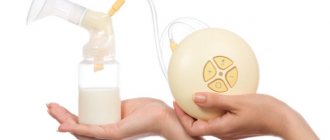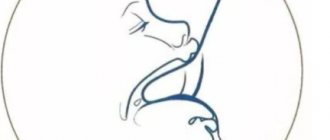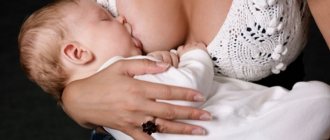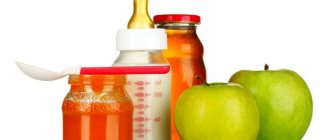No one is immune from the disease. Nursing mothers are no exception. The body, weakened by childbirth, can easily catch an infection. What to do in this case with feeding an infant? Is it possible to feed a baby with mother's fever with breast milk? What to do in such a situation if this is the only source of nutrition for the baby?
Breastfeeding and high fever
Mother's temperature while breastfeeding
A high temperature in a nursing woman is a serious cause for concern. Firstly, the mother’s poor health makes caring for the child much more difficult. Often you cannot do without the help of loved ones in such a situation - you need to perform hygiene procedures, walk and play with the child, and do chores around the house. These daily tasks turn into hard work when there is a high temperature. Secondly, and this is the most important thing, the question arises about the safety of mother's milk for the child. The situation is especially critical when the child is not yet one year old, and breast milk is the only or main component of nutrition for him. So is it possible to feed a baby with a fever, or is this a reason to stop lactation?
Temperature in a nursing mother.
As a rule, women who breastfeed their baby take a very responsible approach to their health, for fear of harming the baby. The most common problem of concern is fever in a nursing mother. There are many reasons for this.
A high temperature during breastfeeding in a mother in the first weeks after the birth of a child is most often associated with inflammation of the mammary gland and postpartum complications. Towards the end of pregnancy, as well as during childbirth, the female body is often exhausted, the level of hemoglobin decreases, which causes a weakening of the immune system. Nosocomial infection, which mother and baby inevitably encounter, can cause an inflammatory reaction in the mammary gland. Infection occurs during breastfeeding, especially with improper latching and cracked nipples. The reason for the rise in temperature in such a situation is beyond doubt, as chest pain, redness and flu-like syndrome increase.
Another reason for an increase in temperature during lactation is postpartum complications. They are not always obvious to women, therefore, if the temperature rises within 30 days after birth, especially without an obvious reason, you should see a doctor in your maternity hospital. In addition to typical problems for the postpartum period, an increase in temperature during breastfeeding may not be associated with lactation and is caused by infectious, acute respiratory diseases, exacerbations of chronic diseases with an increase in temperature.
Reasons for rising temperature
How long should you breastfeed your baby?
Before deciding whether to stop breastfeeding, it is necessary to understand the cause of the fever. It is not a disease in itself, it is just one of the symptoms. In principle, you should not self-medicate, but in relation to a nursing mother it is simply dangerous. There are several reasons why the temperature may rise:
- a viral infection, or a cold, is the most common cause, especially if there is a real carrier of viruses (dad, a visiting grandmother, or an older child brought it from kindergarten or school);
- postpartum inflammatory diseases, if less than a month has passed since the birth of the child - inflammation or suture dehiscence;
- exacerbation of chronic infections (pyelonephritis, herpes);
- mastitis – bacterial inflammation of the mammary gland;
- bacterial diseases of the nasopharynx and tonsils - sore throat, tonsillitis, sinusitis;
- food poisoning;
- pathologies of internal organs.
The decision about the possibility of lactation during the period of treatment of the disease should be made by the doctor after examination and examination.
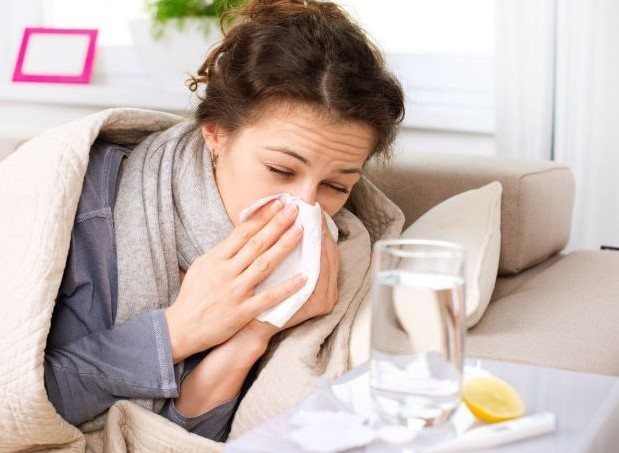
The most common cause of fever is viral infections
Diseases excluding hepatitis B
A fairly common reason for an increase in body temperature in a woman after childbirth is the development of lactostasis. In this case, you need to put your baby to the breast as often as possible and pump regularly to remove excess milk.
If this cannot be achieved in a timely manner, there is a high risk of developing infectious mastitis, especially in the case of pathogenic bacteria. After all, the cause of this disease is most often Staphylococcus aureus, which, together with milk, can enter the baby’s body. In addition, the treatment of mastitis involves the use of strong antibacterial drugs that have the ability to pass into breast milk.

During a viral infection, the mother's body produces antibodies, which, along with breast milk, pass to the baby, providing its protection. Therefore, women with fever can feed the baby, and even need to do so
During lactation, a woman may experience worsening chronic infections - sinusitis, bronchitis, gastritis, tonsillitis, etc. Very often they are accompanied by a strong increase in body temperature. Often the only possible way to treat them is to use antimicrobial agents and other drugs prohibited for use during lactation. If long-term therapy is necessary, it is advisable to transfer the child to an artificial formula.
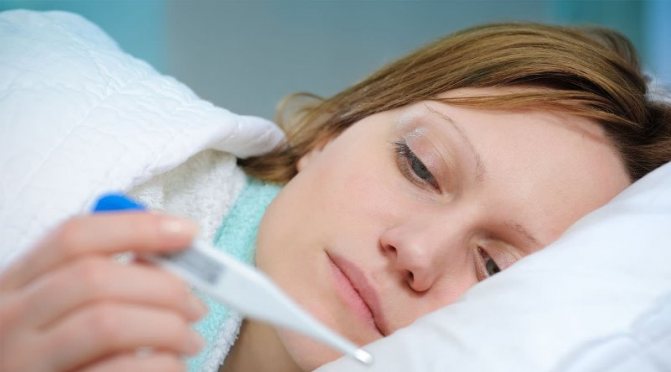
Children who continue natural feeding even when the mother has an elevated temperature receive ready-made antibodies and become resistant to viruses and bacteria. The main thing is to promptly seek advice from a specialist so that he can prescribe medications that are safe for breastfeeding.
Why continue breastfeeding
Until what age should a baby be fed breast milk?
The baby is weaned from the breast in the most extreme cases, when medications are incompatible with lactation, or if there is a risk of transferring the infection to breast milk. There are often situations when the benefits of breastfeeding for a child outweigh the possible risks, so doctors recommend continuing and maintaining lactation during treatment and even hospitalization. It is necessary to continue feeding or express milk regularly to be able to bottle feed your baby.
Important information! If treatment is carried out with antibiotics, you can stop feeding for a while and switch the child to formula, but it is important to express milk up to 6 times a day (according to the number of feedings). This will avoid stagnation of milk and resume feeding after healing.
What to do if I'm breastfeeding and have a sore throat
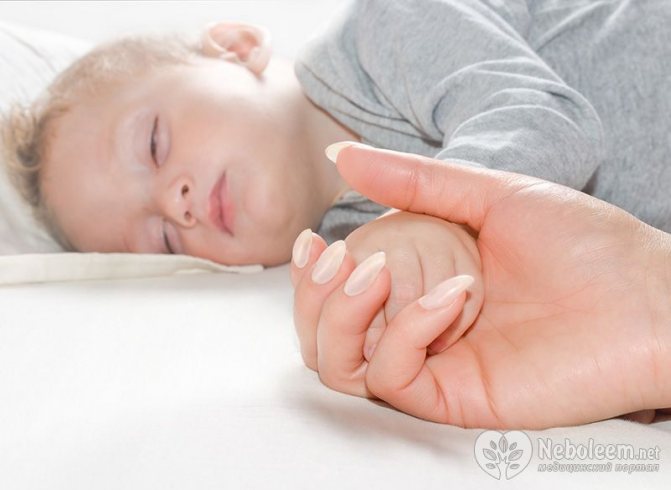
Many mothers are interested in the question of what medications to take if I am breastfeeding and have a sore throat. When breastfeeding with fever and any inflammation, you should take paracetamol in any form (Tylenol, Efferalgan, Panadol) in a dose of no more than 500 mg per dose. A sore throat can be treated with Kameton.
Gargling is a very effective method of treating throat diseases. This is a local remedy that, when breastfeeding with fever and sore throat, does not in any way affect the composition of mother's milk. For rinsing, you can prepare a herbal mixture. Brew fennel herb, eucalyptus leaves, peppermint herb, marshmallow root, thyme or thyme herb, St. John's wort herb and leave overnight (two tablespoons of the mixture per half liter of boiling water). Gargle with the resulting infusion three to four times a day.
Mommies often worry whether they should stop feeding if I am breastfeeding and my throat hurts. You should not stop feeding even if the disease is acute and is caused by various infections. But in case of hospitalization, milk must be expressed at least four to five times a day. After treatment, you should immediately continue breastfeeding. Within a week, the baby will not wean itself off the mother’s breast, and after two to four days, lactation will be completely restored.
The effect of temperature on lactation
How to properly feed a newborn with breast milk
For some reason, it was believed that when body temperature rises, breast milk curdles, becomes sour or bitter, and also changes consistency and color, and it is impossible to feed such milk. These are prejudices.
The only risk in case of illness is the ingress of medicinal substances into the milk that are prohibited for infants, as well as poisoning of the child’s body with toxins that are produced in certain diseases. At elevated temperatures caused by acute respiratory viral infections or acute respiratory infections, protective antibodies are produced in milk. By regularly receiving milk, the baby improves its immunity. During this period, it is important to drink more fluids. The body will replenish fluid loss and reduce the risk of milk stagnation in the glands.
When to stop breastfeeding
In what cases should you stop breastfeeding your baby during a fever? Most doctors advise continuing to feed your baby your milk if the fever rises slightly. The cessation of this process contributes to its even greater increase, as the mammary gland becomes overfilled with milk and lactostasis occurs. To avoid stagnation of milk in the breast, it should be expressed frequently. As a result, lactation may be disrupted because milk residues remain in the breast.
If the temperature rises due to the activity of the virus, then protective antibodies to it immediately begin to form in the mother’s blood. During feeding, they begin to be transmitted to the baby along with milk, helping to protect him from the disease. If the baby is not fed, the risk of infection increases.
If a woman feels well as a result of an increase in temperature and does not require treatment with drugs contraindicated with breastfeeding, then breastfeeding should not be stopped. In addition, it is especially useful at this time. For acute respiratory infections accompanied by cough, runny nose and other symptoms, you need to wear a special medical mask when you need to feed the baby. This will reduce the risk of infection.
Is it necessary to lower the temperature?
It is necessary to bring down the temperature if it exceeds 38 degrees. Up to this point, if the nursing mother feels normal, the body can be allowed to produce antibodies on its own to cope with the disease. You should also take measures to lower your temperature if even a slight increase causes you to feel extremely unwell. Considering that it takes strength to care for and feed a child, this is justified.
Even in the absence of illness, a nursing mother’s temperature can be higher than the accepted norm of 36.6 degrees and reach 37 or even 37.5 degrees.
Important information! During lactation, the temperature in the armpit should be measured 30-40 minutes after feeding or pumping. Before measuring, you need to wipe off the sweat.

Correct temperature measurement
How to measure your temperature correctly when breastfeeding
Indeed, if you measure the temperature in the armpit at the moment when the breasts are full or you have just fed or expressed, then the indicator may be slightly higher than expected.
So, taking these factors into account, the thermometer normally rises to 37.1-37.3°, and occasionally even higher. This is caused by the fact that the milk, which is formed deep in the tissues, has a temperature above 37°. In addition, at the moment when it leaves the chest, the muscles work, the ducts contract, thereby increasing this indicator.
It is correct to measure it in the armpit 25-30 minutes after feeding. Another way is to measure at the elbow. Only in these cases the results will be more reliable.
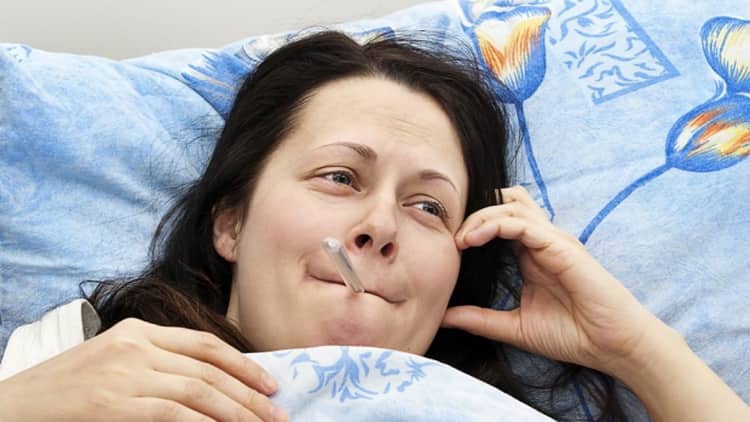
Reasons for increased readings on the thermometer during breastfeeding
The very first thought that arises in our heads and, by the way, the most likely cause of the illness that arises is a viral or bacterial infection. As we all know, this can be most common in the fall and winter. When every day we face hypothermia, temperature changes and vitamin deficiency.
Of course, the risk of infecting the baby is very high, but, looking ahead, I will say that in this case you should under no circumstances refuse to breastfeed. But what to do if you do not have additional symptoms that indicate the development of a cold in your body. In this case, the problem should be looked for elsewhere.
Often, an increased indicator can signal the development of some inflammatory processes in the body, for example:
- Lactation mastitis is an inflammation of the mammary gland. The disease can occur with or without infection. Most often, a woman encounters this problem after discharge from the maternity hospital, although there are cases when the disease strikes while still in the maternity hospital. Many women name the following symptoms of the disease: breast pain and temperature rises to 37° and higher during breastfeeding, in addition, there are some lumps in the mammary glands. The reasons for the development of mastitis may be lactostasis or, as it is also called, milk stagnation. Since stagnant milk is the most favorable environment for the growth of bacteria.

- Lactostasis , as you understand, is one of the precursors of mastitis. It means stagnation of milk in the breast. May be accompanied by unpleasant aching pain. And when you palpate the mammary glands, you will feel a lump.
- Postpartum inflammatory diseases: endomeritis, suture dehiscence after cesarean section or in the perineum. In addition, this may be associated with exacerbation of chronic diseases: pyelonephritis, herpes, etc.
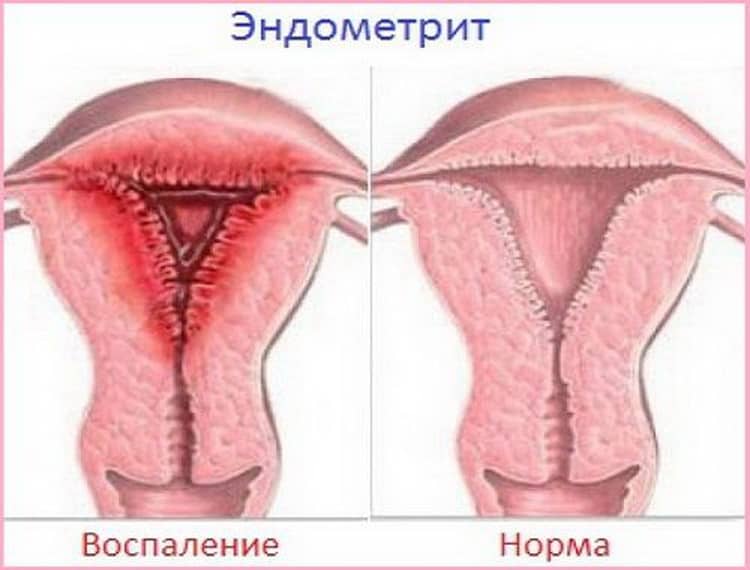
- Poisoning.
- Development of the inflammatory process in the uterine cavity.
A doctor can accurately diagnose the cause of an elevated temperature. It will be based on the characteristics of your body, what diseases you suffered or are suffering from, as well as the amount of time that has passed since childbirth.
What medications for fever are safe during lactation?
If the temperature has increased uncritically, and the general condition is satisfactory, stable, without deterioration, you can observe the body for 1-2 days. The reason for the increase in temperature may be chronic fatigue due to lack of sleep. It is necessary to reconsider the daily routine, allocate enough time for rest and sleep. It is possible that these measures will normalize the condition.
If concomitant symptoms characteristic of ARVI are detected, such as a runny nose and cough, it is necessary to drink plenty of fluids as therapy. Cranberry and lingonberry fruit drinks and tea with lemon are ideal for these purposes. The best folk remedy for fever is raspberry jam, it helps to sweat. Before eating, you need to drink plenty of warm liquid. In addition, during breastfeeding, you should not get carried away with it, so that the child does not develop an allergy.
Regular nasal rinsing with saline solutions, steam inhalation and gargling are helpful. It is also necessary to observe the temperature and humidity conditions in the room where the child and mother are. Cool, moist air will prevent the mucus in the nasopharynx from thickening.
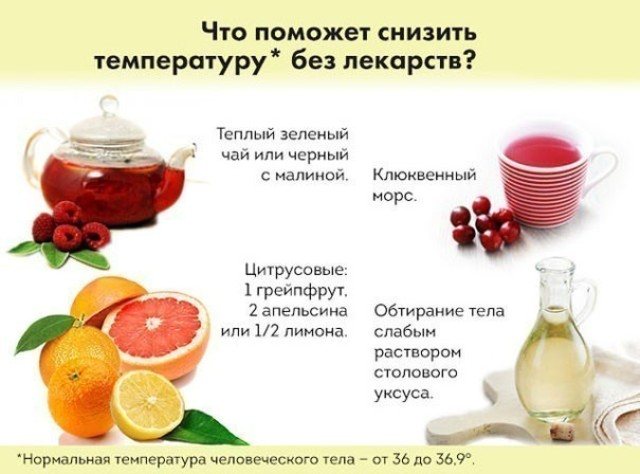
Folk home remedies
Important information! If you have mastitis, drinking plenty of fluids is contraindicated; it will cause a sudden flow of milk, which will worsen the condition.
If the dynamics are negative, and there is no improvement on the 3rd day after the onset of symptoms of the disease, it is necessary to take an antipyretic drug. Provided lactation continues, only drugs based on two active substances can be approved medications:
- paracetamol;
- ibuprofen.
Despite the fact that they pass into breast milk, their effects are safe for the baby. It is these medications in the form of syrups and suppositories that are approved for use directly by children. The dosage for an adult must be calculated based on weight. It is necessary to take medications immediately after feeding, so that by the next feeding the concentration of the active substance is already minimal. During the day, when you urgently need to bring down the temperature, the recommended form of medication is tablets and syrup, and use a candle at night. The action of the suppository is longer, and the medicine in this form passes minimally into breast milk.
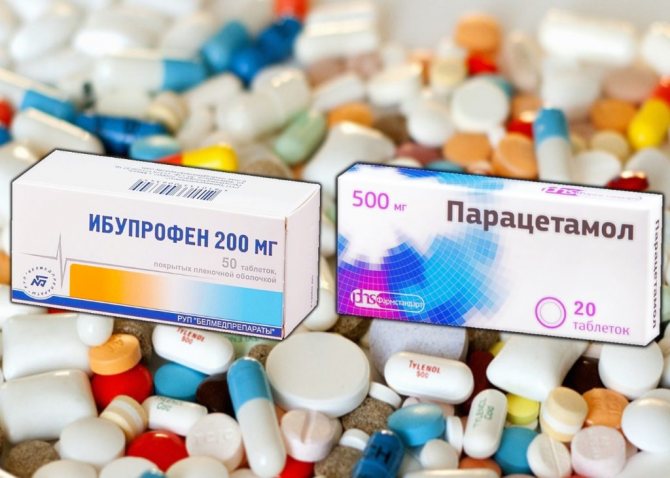
Approved medications for lactation
It is strictly forbidden to take aspirin-based medications during lactation, as well as effervescent soluble tablets. The risk of negative consequences for the child after a nursing mother takes such medications is very high. The brain and liver are at risk. If there are no approved medications at home, it is better to use home methods: cold compresses and rubbing, rather than taking substances that are dangerous to the child’s life.
Breastfeeding during ARVI
During lactation, a woman’s body experiences increased stress, the immune system weakens, as a result of which the young mother can get sick if she encounters any virus. This happens especially often during the seasonal increase in the level of acute respiratory viral infections in the autumn-winter time. What to do? How to maintain lactation and not infect the child?
An increase in maternal temperature due to acute respiratory infections is not a contraindication to continuing breastfeeding. However, during this period, the woman must follow certain recommendations so as not to infect the baby.

Some pathogens and their toxins can pass into breast milk. This poses a threat to the baby's health.
First of all, mommy needs to be isolated in a separate room, with dishes and linen provided. Regularly carry out wet cleaning and ventilation of premises, since viruses are characterized by high volatility. During any contact with the baby, a woman should wear a disposable mask.
Breastfeeding at fever should also be carried out exclusively in personal protective equipment. Under no circumstances should you remove the mask, even for a few minutes, as this risks infecting the baby.
At high temperatures, a woman should take antipyretic drugs approved for breastfeeding or turn to traditional medicine. A doctor should decide whether to use a particular drug. A woman must adhere not only to the recommended dosages, but also to the specifics of use. In particular, take the medicine immediately after feeding the baby, then by the time the child eats the next meal, the concentration of the drug in the blood will decrease significantly.
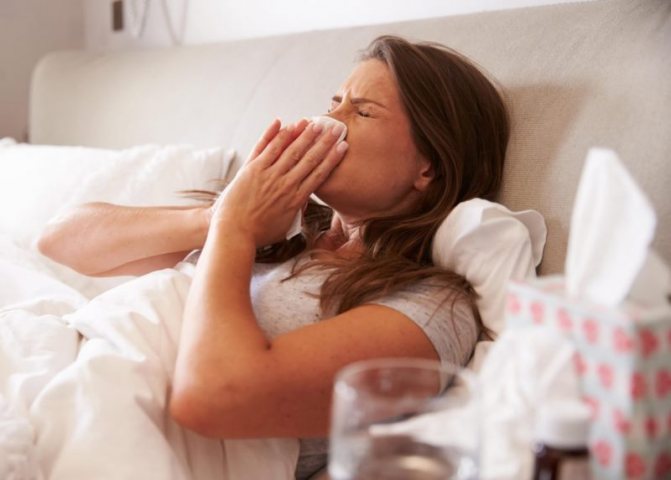
First of all, she needs to be isolated in a separate room, with dishes and linen allocated
There are a number of drugs that are approved for use during breastfeeding. The safest products that are allowed at temperatures of 38 °C or more are Paracetamol, Ibuprofen and other drugs based on them. These drugs are prescribed even to newborns, so even if an insignificant dose of the active substance gets into the milk, there will be no harm to the baby.
During a viral infection, the mother's body produces antibodies, which, along with breast milk, pass to the baby, providing its protection. Therefore, women with fever can feed the baby, and even need to do so.
When to stop breastfeeding
The issue of continuing guardianship or a temporary break should be decided after a doctor’s examination. It is necessary to evaluate and weigh the risks that are possible for the child if the mother is ill and takes medications.
When is breastfeeding allowed?
In case of the following diseases, accompanied by elevated temperature (increased within reasonable limits, up to 38 °), lactation can and should be maintained:
- With acute respiratory infections and acute respiratory viral infections, sometimes called “colds,” a nursing mother, in close contact with her child, in any case transmitted the virus to him. As the temperature rises, the female body begins to produce interferon to fight the virus. Antibodies also penetrate into milk, so the baby either will not get sick at all, or will easily tolerate the disease, developing protective immunity for the future;
- Lactostasis and mastitis in the early stage (not purulent) are not reasons for interrupting breastfeeding; on the contrary, successful treatment requires regular emptying of the breast; otherwise the chest will overflow and cause an even higher fever;
- A mild intestinal infection goes away after the gastrointestinal tract is completely cleansed of toxins. This happens within a day if you follow a diet. Feeding should be continued to develop antibodies in the milk to the infection.
When should lactation be stopped?
Most diseases do not pose a risk to the baby, and lactation can continue. However, there are a number of diseases in which feeding will need to be interrupted for a while. These include:
- pneumonia;
- purulent sore throat;
- purulent mastitis;
- cystitis;
- severe form of intestinal infection;
- dysentery.
Due to the serious condition of the mother with such diseases, milk production may decrease, but it still requires a sufficient amount of energy. Therefore, first of all, treatment is necessary. A significant increase in temperature is caused by bacterial infections that are treated with antibiotics. By themselves, they are rarely compatible with lactation and can cause allergies and dysbacteriosis. Diseases are also dangerous for the baby due to toxins that penetrate into the milk. For a newborn baby, this will have a detrimental effect on the condition.
Ways to reduce temperature
Paracetamol and Ibuprofen will help reduce the temperature during breastfeeding, but first you should seek help from a doctor so that he can tell you what medications are needed for therapy.
It is worth noting that the funds should be taken only if the readings are at around 39 degrees. Not all medications are approved for use, since they penetrate into milk, which means they will enter the child’s body.
At 38 degrees, the use of drugs is not recommended, especially for colds, since the patient’s body independently fights the infection. Traditional medicine or modern drugs can help with fever. First, it’s worth taking a closer look at the medication method:
- Necessary children's medications for fever in syrups. The most optimal and safe means include those medications that are allowed to be given to children to normalize the condition. They usually contain Paracetamol and Ibuprofen. Such substances are safe for women and will not affect the condition of the newborn in any way.
- Antipyretics in suppositories. Taking medications can negatively affect the condition of the stomach; to avoid this, doctors advise using suppositories. The components are absorbed into the intestines and reduce the high temperature, but the amount of substances in the milk will be significantly lower.
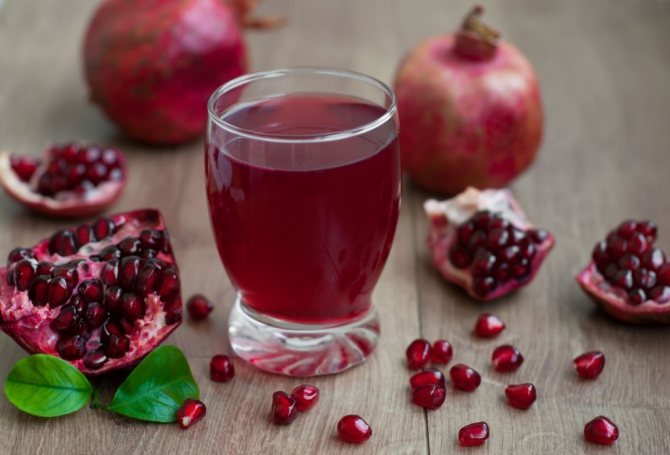
You can also turn to traditional medicine methods. But when using such products, it is worth remembering that the child may experience intolerance to the components or an allergic reaction to them. The most popular and effective include:
- Drink plenty of fluids. This is the easiest option to improve your condition; you can drink juices, water, tea and fruit drinks, but only warm.
- Adding honey and lemon. Two more components that have an anti-inflammatory effect. But a baby may be allergic to honey and citrus.
- Raspberry jam. An old recipe from grandmothers that helps bring down the temperature, since the jam contains a lot of vitamin C. If there is no jam, raspberry leaves are brewed.
- Bed rest. Without medications, not only drinking, but also proper rest will help you cope with the disease.
- Cool compresses and rubdown. To do this, you can only use warm water with vinegar added. The use of vodka or alcohol is strictly prohibited, since alcohol penetrates the blood and then enters the milk.
We recommend reading: Monural during breastfeeding: is it possible for a nursing mother, instructions for use, reviews
In difficult cases, you will have to use stronger means for treatment; antibiotics are prescribed only by the attending physician, correctly determining the dosage. In this case, you will have to temporarily stop feeding the baby milk.
How to maintain lactation during treatment
If the disease allows you to maintain lactation, you must continue to feed as usual, as before the disease. In a situation where the doctor has prescribed a temporary interruption of lactation for the period of therapy, you should pump regularly. This way the milk will not go to waste, since the need for it will not decrease. After recovery, you can continue to feed successfully.
Not so long ago, there was a time when, if a mother was ill, they were advised to boil expressed milk and, after heat treatment, give it to the baby through a bottle. Modern pediatricians categorically insist not to do this, since after boiling all the beneficial microelements from milk disappear, and it has no biological value.
If the mother is taking medications that are not compatible with feeding, or the infection is severely bacterial, the expressed milk should be discarded. During this period, the baby must be switched to artificial nutrition and fed with infant formula. After recovery and consultation with your doctor about the time period for complete removal of medications from the body, breastfeeding can be continued.

Pumping to maintain lactation
An increase in temperature in a nursing mother is not always a reason to interrupt or even stop breastfeeding. Sometimes a child can and should continue to be fed at a high temperature. This is what allows him to more easily endure the infection and develop protective immunity. The diagnosis of a disease of which hyperthermia is a symptom should be made by a qualified physician.
Is it possible to breastfeed at a fever?
When the temperature has reached a critical point, it is necessary not only to select the appropriate drug, but also to decide whether there is a need to stop breastfeeding. There are several important pathologies in which giving breast milk to a baby can be dangerous:
- anthrax;
- blood diseases that are severe;
- various diseases of the genitourinary system;
- tetanus;
- kidney diseases of various etiologies;
- open form of tuberculosis;
- advanced mastitis;
- syphilis of any stage.
We recommend reading: The benefits and harms of breastfeeding for a child and mother, reviews
When taking some antibacterial drugs, feeding is completely stopped for the period of therapy. But in most cases, the doctor selects medications that are suitable for nursing mothers. When the temperature reaches 38 degrees, it is better to stop feeding, as toxins penetrate into the milk and can harm the baby.

In any case, it is better not to treat the disease, but to prevent it; for this, the nursing mother must choose a diet that will replenish all the necessary vitamins and minerals. The diet should include fruits and vegetables, as well as meat and dairy products. Healthy nutrition will be the key to the full development of the baby. If your body temperature rises, it is better to seek help from a doctor rather than self-medicate.


